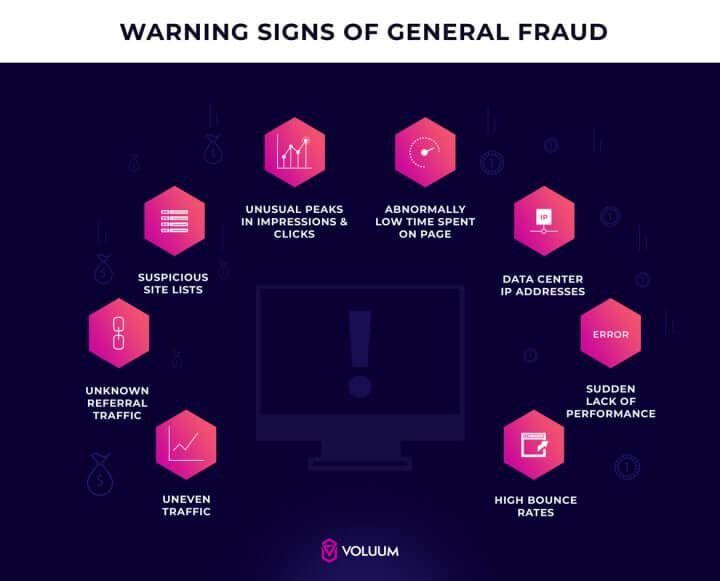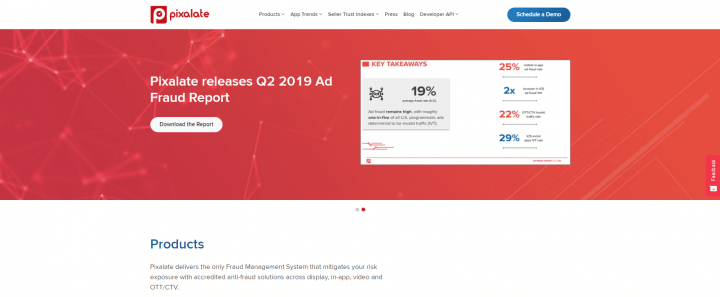
Digital advertising is a humongous business where hundreds of billions of dollars are spent every year. Much like any other field involving massive amounts of money, the arena of online advertisements, too, attracts fraudsters. Digital ad fraud is constantly in the news. While some claim it to be not that big of a deal, the wise ones know that it is a matter of serious concern. Either way, it’s an issue that can’t be ignored.
The statistics from eMarketer’s digital ad fraud survey state that digital ad fraud is the second most concerning topic for the US Media Buyers as far as programmatic advertising is concerned. According to the report released by techARC, digital commerce contributes to more than half of the total ad fraud in India. At $1.63 billion, digital ad fraud accounts for 8.7% in India out of the global total.
Despite digital ad fraud being one of the most pertinent problems in the performance marketing industry, businesses and advertisers often don’t take drastic measures to tackle it. This is probably due to the lack of knowledge regarding the matter. Measuring the overall estimate of ad fraud is tricky, but the recent calculations put it somewhere between $6.5 billion to as high as $19 billion.
Post Quick Links
Jump straight to the section of the post you want to read:
WHAT IS DIGITAL AD FRAUD?
Digital ad fraud can be defined as a malicious, deliberate act of manipulating the proper delivery of ad content and hiding it from its target audience. Ad frauds are conducted by creating fake ad traffic with the help of content /web scraping websites and other environments. Ad fraudsters tend to launch ads outside of a user’s view and create other fictitious mechanisms to deliver ads that can’t be seen by the consumers. It was predicted that in 2019 alone, fraudsters would earn $5.8 billion from digital ad frauds.
Fraudsters are enticed by ad frauds even more so because not only is there a lot of money involved, the risk isn’t much as well, unfortunately. Unlike card fraud, ad fraud doesn’t earn one a long period of imprisonment or punishment.
“In a Q3 2018 study, Pixalate found that 19% of worldwide OTT impressions were invalid, due to a combination of fraud and ad serving and measurement errors caused by technical malfunctions.”, says eMarketer in a study focused on the increasing threat of OTT ad fraud.
There are multiple levels in which digital ad frauds can operate. In addition to manipulating with traffic, it can also work with more sophisticated things such as impressions, conversions, and a complete imitation of user activity. Since ad campaigns are all based on numbers and statistics, these primary elements being meddled with causes a lot of loss to companies, monetary and otherwise.
Distorted stats come as a huge blow to marketing companies. While financial losses reflect on the forefront, the absence of sufficient information regrading the campaign and its future is what affects the marketers the most. Despite a well-chosen strategy, the presence of malicious sources defeats the purpose of the ad campaign.
WARNING SIGNS OF AD FRAUD
Detecting ad fraud isn’t exactly rocket science. There are obvious warnings that indicate whenever something is fishy. Here are some of the warnings of ad fraud to look out for:
1 . SUDDEN RISE IN CLICKS AND IMPRESSIONS
The first sign is if you see an unusual rise in clicks and impressions. We all hope for the digital world out there to notice our content, but it can’t happen without a strong marketing push. Clicks and impressions usually increase in the mornings and evenings. If you see them rising during the afternoon or the dull hours, you should know it’s a sign of ad fraud.
INCREASE IN PAGE VIEWS
In case the number of impressions and clicks have gone up for you overnight, it should equate to an increase in page views as well. However, if that’s not the case, you should understand that customers aren’t being drawn to your site at all.
ACCELERATED BOUNCER RATES
Elevated bouncer rates occur when visitors tend to leave your site almost soon after clicking on it.

Source: https://voluum.com/blog/digital-ad-fraud-complete-guide-advertisers-part-2/
When that’s combined with higher impressions and lower conversions, it’s an indication of ad fraud. This is especially indicative if your offers or other marketing efforts have stayed the same throughout a given period of time.
SUSPICIOUS SITE LISTS
Suspicious site lists, too, are major warnings of digital ad fraud. Audit your site-level reporting, and if you come across any unrecognisable sites, that should be reason enough to believe that you’re being trapped under ad fraud.
DUBIOUS IP ADDRESS
The IP address of your viewers can provide proof of ad fraud, too. If the visitor to your page originates from a hosted server, it’s a warning sign for ad fraud. You can often get a refund from your agency or ad-buying platform if you prove that the IP address is from a hosted server.
TYPES OF AD FRAUD
There are various categories of ad fraud that exist. Here are some of their features and how you can identify them:
1 . BOTS
Bots can perform several human activities. They can generate traffic, click on links, and even target and segment like any other user. They can also fill forms and watch videos. They trick advertisers into believing that real users have completed specific actions. Therefore, advertisers end up paying publishers for impressions or clicks that the target audience hasn’t even seen.
GHOST SITES
Ghost sites are real websites with real content that is usually falsely produced or stolen from legitimate websites. The only purpose of these websites is to trick advertisers. These sites are made available through ad networks or exchanges that participate in Real Time Bidding environments.
AD STACKING
Ad stacking takes places when multiple ads are stacked on top of each other, and only the top one is visible to the viewer. Therefore, the publisher can generate multiple impressions for a single page view and get credit for running the ad.
COOKIE STUFFING
When multiple cookies are attached to a user without their knowledge, it’s known as cookie stuffing. When these users convert later, the fraudsters make money, which means that the affiliate who actually contributed to the conversion doesn’t get his due. Cookie stuffing presents misleading and diluted audience information, thereby messing up the results of an entire campaign.
DOMAIN SPOOFING
Domain spooking is a scheme wherein deceitful publishers, ad exchanges, or networks make the nature of their website traffic resemble that of legit websites. For instance, an advertiser could think that he’s promoting to run a campaign on a legitimate website with high traffic, but instead the ad ends up being featured on an unknown website. This is harmful to the advertisers as their offers often end up being next to unwanted content.
ZERO-AD SITES
Zero-ad sites are those websites where advertising is forbidden, like government or educational sites. The fraudsters, however, find a way to inject ads into them whenever a user downloads and installs a browser extension or app. These are, in turn, compiled with software that quietly injects unwanted ads into the user’s browser.
CLICK FARMS
Click farms or click fraud is one of the most common and easiest kinds of ad fraud that is prevalent. Click farms are large groups of people who are paid to click on ads. This kind of fraud can be spotted by paying attention to analytics. For example, if a lot of clicks are suddenly spotted coming from developing countries such as India or Bangladesh, it is usually an indication of click fraud. Click fraud can be detected by checking the reports on subjects such as IP addresses, click timestamp, action timestamp, and user agent.
HOW TO PREVENT DIGITAL AD FRAUD?
There are ways in which advertisers can save themselves from the pain of digital ad frauds. They don’t always have to be too expensive or time-consuming. In fact, most of them involve caution and common sense. Some of the prevention measures are as follows:
1 . Awareness is the first and foremost way to prevent yourself from digital ad fraud. Be aware of its existence, magnitude, and the effects it can have on your business. Ad fraud is often overlooked by policymakers and the public who tend to be dismissive of its impact on the global economy and society.
Interesting Read : Six Best Practices to Prevent Ad Fraud
- There’s no better way to defeat a common enemy than coming together to fight it for good. Therefore, self-regulation of the advertising industry is extremely pertinent. Advertisers, ad tech platforms, publishers, financial institutions, payment and hosting vendors, and internet providers should create a common global association to discuss strategies that can help them set common ad standards and requirements and save them from fraudsters.
- There are vendors who sell a fixed number of website visits for a fixed price. The best way to keep bots away from your site is by avoiding to get into the practice of purchasing sourced traffic. Instead, drive human traffic to your website through honest methods such as email campaigns, social media posts, and search engine marketing.
4. The current GDPR regulations dictate that some of the data is anonymised due to privacy restrictions, thereby making it difficult to recognise and block fraudulent clicks. One way to fight that is by optimising privacy legislation through balancing consumer privacy and consumer safety from ad fraud.
5. Advertisers should constantly monitor their traffic to know where it’s coming from. Determining whether the traffic is generating from a social media campaign or an email blast is comparatively simpler. However, if you notice unusual spikes at unusual hours, they indicate ad fraud being taken place. This should be addressed immediately. Publishers can do this by protecting media buyers with the step of filtering traffic from bots and data centers, and also encouraging their advertising partners to do so.
AD FRAUD DETECTION COMPANIES
Be it non-human traffic or ad injection, ad fraud detection companies take care of similar issues to save the publishers from revenue losses. If you’re looking for someone to help you with that, following are some of the best ad fraud detection companies to turn to:
1 . WHITE OPS
Established in 2012, White Ops was accredited by MRC for sophisticated invalid traffic detection in 2016. The cybersecurity company offers protection against ad fraud and similar threats to digital publishers and advertisers. The company has two main offerings, namely MediaGuard and FraudSensor. These aid in combating specific categories of ad fraud and eliminating non-human traffic from publishers’ inventory.
Interesting Read : Ad fraud detection: A guide for marketers
PIXALATE

Having partnered with reputed ad-tech vendors including OpenX, AdRoll, and Centro, Pixalate can prevent 15 types of frauds and monitor over 50 million URLs. It’s a cross-channel fraud intelligence company that works with publishers to prevent invalid traffic and improve ad inventory quality. Pixalate’s services are available across display, app, and video platforms.
DOUBLEVERIFY

Having its own proprietary platform known as DV Pinnacle, DoubleVerify ensures viewable, fraud-free, and brand safety ads. It provides information for delivered ads, including whether the ads are viewable and being seen by humans or not. The publishers are given access to a comprehensive dashboard that helps in improving their inventory quality.
TRUST METRICS
Providing quarterly analysis for publishers to measure, optimise, and benchmark their inventories, Trust Metrics has over 1500 variables to help the publishers in building a high-quality website. It assists them in making decisions regarding expanding inventories, brand partnerships, niche rank, and optimisation.
IAS (INTEGRAL AD SCIENCE)
IAS has been associated with privileged names such as Adobe, AOL, and DoubleClick Bid Manager by Google. Founded in 2009, IAS supplies publishers, advertisers, brands, and agencies with a stream of optimisation and verification products. It offers a service called as ‘True Advertising Quality’ that scores sellers and buyers based on metrics like brand safety, ad fraud, content, structure, and view.


About the author
Rachael Chapman
A Complete Gamer and a Tech Geek. Brings out all her thoughts and Love in Writing Techie Blogs.
Related Articles
Why the blend of Jarvee and Instagram is better for your brand growth?
To grow better online, having just one social media handle isn’t enough. Know why the blend of Jarvee and Instagram is better for your brand growth
How to Unblock Match.Com Using Private Proxies
One of the most popular dating sites right now is match.com. Know How to Unblock Match.Com with Private Proxies by Limeproxies